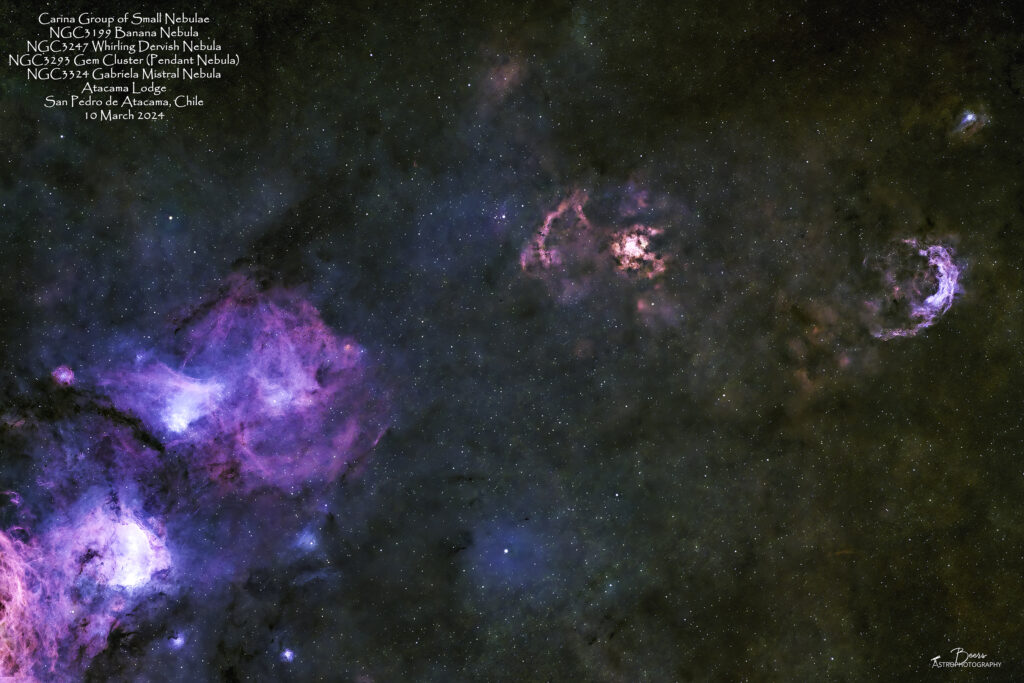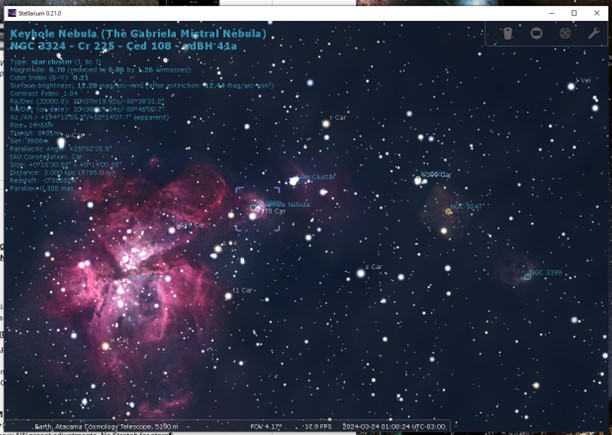
Fun facts
Stellarium screenshot shows the location of the four nebulae captured in this image

Imaging the Southern Sky by Stephen Chadwick & Ian Cooper describes this area of The Eta Carina Area on pp 73-83.
{ From their individual object Wikipedia pages }
NGC 3199 Banana Nebula is an emission nebula in the constellation Carina. It is commonly known as the Banana Nebula. The object was discovered in 1826 by the Scottish astronomer James Dunlop.[5] It was thought to be the bow shock around the central star, WR 18, an especially hot and luminous Wolf–Rayet star; however, it was determined that the nebula formed due to the composition of local space, not because of the star’s movement.
RCW 49, also known as NGC 3247 Whirling Dervish Nebula, is a H II region nebula located 13,700 light years away. Other designations for the RCW 49 region include NGC 3247 and G29[3] and it is commonly known as the Whirling Dervish Nebula. It is a dusty stellar nursery that contains more than 2,200 stars and is about 300-400 light years across. RCW 49 is recognized as among the brightest and most massive HII regions.
NGC 3293 Gem Cluster (Pendant Nebula) is an open cluster in the Carina constellation. It was discovered by Nicolas-Louis de Lacaille in 1751. It consists of more than 100 stars brighter than 14th magnitude in a 10 arc minute field, the brightest of which are blue supergiants of apparent magnitude 6.5 and 6.7. There is also a 7th magnitude pulsating red supergiant, V361 Carinae.
NGC 3324 Gabriela Mistral Nebula is an open cluster in the southern constellation Carina, located northwest of the Carina Nebula (NGC 3372) at a distance of 9,100 ly (2,800 pc) from Earth. It is closely associated with the emission nebula IC 2599, also known as Gum 31. The two are often confused as a single object, and together have been nicknamed the “Gabriela Mistral Nebula” due to its resemblance to the Chilean poet. NGC 3324 was first catalogued by James Dunlop in 1826.
Capture & Processing Notes
On night #5 of the Atacama Desert trip, I imaged a two-tile image of the Vela SNR Crest & Bridge from sunset until it set at 0400. Then switched to (what I’m calling) the Carina group (Keyhole, Banana, Whirling Dervish, Gabriel Mistral) from 0400 until sunrise at 0645.
Sequence Plan:
- Sequence plan: Gain 158, Temp: 0°C, 26x5min, Total time = 130 minutes, 2:10 hours.
- Captured: Night of 10 March 2024 (11Mar2024, 0424CDT – 11Mar2024, 0645CDT)
- Shooting location: Atacama Lodge, San Pedro de Atacama, Chile
Processing summary: Captured with SGP. Stacked in APP. Star removal with Starnet++. Processed in LR/PS
Equipment
All equipment controlled by HP Probook (DSO CTRL 1) Windows 10 laptop running Sequence Generator Pro v4.3.0.1305.
- Polar alignment: QHYCCD camera (controlled by Polemaster for polar alignment)
- Imaging: (Southern Cross) Askar FRA600 on Rainbow Astro RC-135E, ZWO ASI2400MC#1 camera
- Autofocuser: ZWO EAF ( Electronic Automatic Focuser)
- Mount: Rainbow Astro RST-135E (controlled by iHubo ASCOM driver)
- Autoguiding: Orion 60mm Multi-Use Guide Scope with Orion StarShoot AutoGuider Pro Mono Astrophotography Camera (controlled by PHD2)
